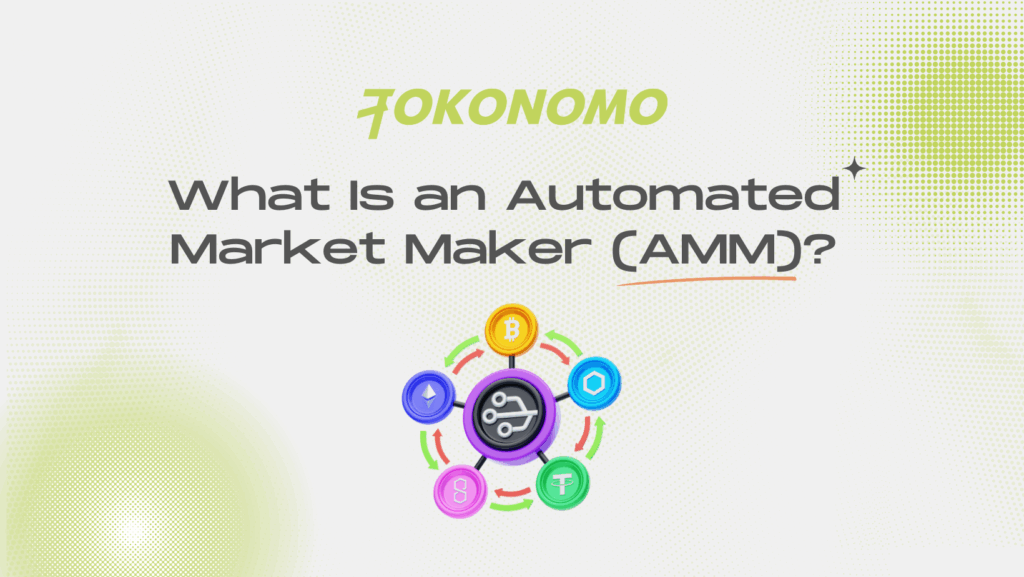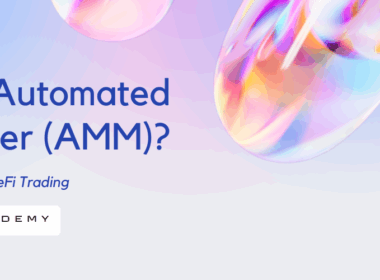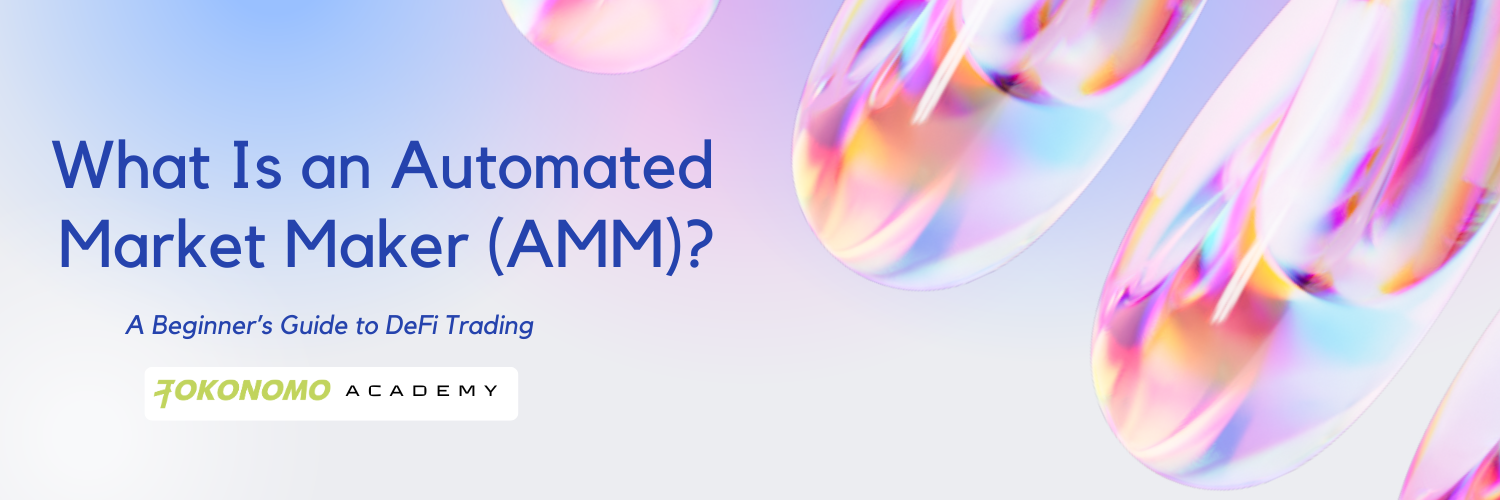Table of Contents
Introduction
Decentralized finance, or DeFi, has taken the crypto world by storm, offering a new way to trade, lend, and invest without middlemen. At the heart of this revolution lies the Automated Market Maker (AMM), a game-changing technology powering many of the most popular DeFi platforms. If you’re new to DeFi trading and wondering how you can swap tokens instantly without a traditional exchange, AMMs are the answer. In this beginner’s guide, we’ll break down what an Automated Market Maker is, how it works, and why it’s become a cornerstone of decentralized exchanges (DEXs). Whether you’re curious about liquidity pools or want to dive into AMM trading strategies, we’ve got you covered.
What Is an Automated Market Maker (AMM)?
Let’s start with the basics. An Automated Market Maker (AMM) is a type of protocol used in DeFi to facilitate trading without the need for traditional order books found on centralized exchanges like Binance or Coinbase. Instead of matching buyers and sellers, AMMs rely on algorithms and smart contracts to determine asset prices and execute trades. Think of it as a robotic market maker that’s always ready to trade, no matter the time of day.


Unlike traditional markets, where liquidity depends on active participants, AMMs use liquidity pools—pools of tokens provided by users—to ensure there’s always enough liquidity for trading. This innovation, pioneered by platforms like Uniswap, has made DeFi trading accessible to anyone with an internet connection and a crypto wallet. According to data from DeFiLlama (as of September 2025), over $160 billion in total value locked (TVL) is tied to DeFi protocols, with a significant chunk powering AMM-based decentralized exchanges.
Why AMMs Exist: The Problem They Solve
Before AMMs came along, trading lesser-known tokens was a nightmare. Centralized exchanges often refused to list small or niche tokens due to low trading volume, leaving investors with few options. Even when tokens were listed, thin order books led to high slippage and poor pricing. Enter the automated market maker—a solution to the liquidity problem.
AMMs democratize trading by allowing anyone to create a market for any token pair. They eliminate the need for a counterparty, meaning you don’t have to wait for someone to take the other side of your trade. This is a big deal for DeFi trading, as it enables the seamless exchange of assets, even in low-liquidity markets. As noted by our analysts, AMMs have been instrumental in onboarding millions of users to DeFi since their rise in 2020.
How Automated Market Maker Works
Now that we’ve covered the “why,” let’s dive into the “how.” At their core, AMMs are powered by smart contracts—self-executing code on blockchains like Ethereum—that manage trades and pricing. But what makes them tick? Let’s break it down into key components.
The Core Concept: Liquidity Pools
Instead of order books, AMMs rely on liquidity pools. These are pools of two or more tokens locked in a smart contract, contributed by users known as liquidity providers (LPs). For example, a pool on Uniswap might consist of ETH and a stablecoin like USDC. When you trade ETH for USDC, you’re essentially interacting with this pool, not another trader. The pool’s balance shifts with each trade, and the price adjusts accordingly.
Liquidity providers earn a share of the trading fees, incentivizing them to stake their tokens. This system ensures there’s always liquidity for AMM trading strategies, even for obscure tokens.
The Automated Market Maker Formula (x*y=k)
Here’s where the magic happens. Most AMMs use a mathematical formula to determine pricing, with the most common being the constant product formula: x*y=k. In this equation, “x” and “y” represent the quantities of two tokens in a pool, and “k” is a constant. This formula ensures that the product of the two token quantities remains constant, even as trades occur.
Let’s say a pool has 100 ETH and 200,000 USDC, making k = 20,000,000. If someone buys 1 ETH, the pool must adjust the USDC amount to maintain the constant “k.” The result? The price of ETH rises as its supply in the pool decreases. This mechanism is the backbone of decentralized exchange trading and ensures automatic price discovery without human intervention.
Fees and Incentives
Trading on an AMM isn’t free. Each transaction incurs a small fee—often between 0.1% and 0.3%—which is distributed to liquidity providers as a reward. This fee structure not only compensates LPs but also discourages excessive trading that could destabilize pools. Some platforms, like Curve, even offer additional incentives through yield farming, where LPs earn native tokens on top of fees. It’s a win-win for those diving into liquidity provision in DeFi.
Popular Types of AMMs
Not all AMMs are created equal. Over the years, developers have tweaked the basic model to suit different use cases. Here are some of the most popular types shaping DeFi trading today:
- Constant Product Market Makers (CPMMs): Used by Uniswap, these rely on the x*y=k formula. They’re ideal for general-purpose token swaps.
- Constant Sum Market Makers (CSMMs): These maintain a fixed sum of tokens (x+y=k) and are better for stablecoin pairs with minimal price volatility.
- Hybrid AMMs: Platforms like Balancer combine multiple formulas to support pools with more than two tokens, offering flexibility for complex AMM trading strategies.
Each type has its strengths, and choosing the right one depends on your goals in decentralized exchange trading.
Benefits of Using AMMs
Why should you care about AMMs? For starters, they’ve made DeFi trading incredibly accessible. Here are some standout benefits:
- 24/7 Liquidity: Unlike centralized exchanges, AMMs never sleep. You can trade anytime, anywhere.
- Permissionless Access: No KYC, no barriers—just connect your wallet and start trading on a decentralized exchange.
- Token Diversity: AMMs support countless token pairs, including those not listed on major exchanges.
- Earning Opportunities: Through liquidity provision in DeFi, users can earn passive income from trading fees and rewards.
These advantages have fueled the explosive growth of AMMs, with platforms like Uniswap handling billions in daily trading volume, as reported by Messari in their Q2 2025 report.
Risks and Challenges of AMMs
While AMMs are revolutionary, they’re not without flaws. If you’re jumping into DeFi trading, you need to be aware of the risks:
- Impermanent Loss: Liquidity providers can lose value if the price of tokens in a pool diverges significantly. It’s a hidden cost of liquidity provision in DeFi.
- Slippage: Large trades on small pools can cause significant price shifts, leading to unexpected losses.
- Smart Contract Risks: Bugs or hacks in AMM protocols can result in lost funds. Always research a platform’s security track record.
Navigating these challenges requires caution and a solid understanding of AMM trading strategies. Don’t dive in blind—do your homework.
How to Get Started with AMMs
Ready to explore decentralized exchange trading? Here’s a quick roadmap to get started with AMMs:
- Set Up a Wallet: Use a non-custodial wallet like MetaMask to interact with DeFi platforms.
- Choose a Platform: Popular AMMs include Uniswap, SushiSwap, and Curve. Pick one based on your trading needs.
- Fund Your Wallet: Add ETH or another base token to cover gas fees and trades.
- Trade or Provide Liquidity: Swap tokens directly or stake assets in liquidity pools to earn fees.
Start small, experiment with different AMM trading strategies, and always double-check transaction details to avoid costly mistakes. Want to learn more about mastering DeFi? Check out our comprehensive guides at DeFi Academy.
Future of Automated Market Maker
Where are AMMs headed? As DeFi evolves, so do these protocols. Innovations like concentrated liquidity (introduced by Uniswap V3) are making pools more capital-efficient, while cross-chain AMMs are bridging liquidity across blockchains. With over $50 billion in TVL tied to AMMs alone (per DeFiLlama, September 2025), the future looks bright.
However, regulatory scrutiny and scalability challenges loom large. Will AMMs adapt to stricter rules, or will they remain a wild west of finance? Only time will tell, but one thing’s certain: AMMs will continue shaping DeFi trading for years to come.
Conclusion
From solving liquidity woes to enabling permissionless trading, the Automated Market Maker (AMM) has redefined what’s possible in DeFi trading. Whether you’re swapping tokens on a decentralized exchange or staking assets in liquidity pools, AMMs offer a gateway to a financial system free from intermediaries. But with great power comes great responsibility—understand the risks, refine your AMM trading strategies, and stay informed about this fast-moving space. Curious to dive deeper into liquidity provision in DeFi? Stick with DeFi Academy for more insights and expert tips.
FAQs (Frequently Asked Questions)
- What is an Automated Market Maker in simple terms?
An AMM is a type of decentralized trading system that lets you swap crypto tokens without needing a buyer or seller on the other side. Instead of traditional order books, AMMs use liquidity pools and algorithms to determine prices automatically.
- How is an AMM different from a centralized exchange like Binance or Coinbase?
Centralized exchanges match buyers and sellers through order books, while AMMs rely on smart contracts and liquidity pools. With AMMs, anyone can provide liquidity and trade without KYC or a central authority controlling the process.
- What are liquidity pools, and why are they important?
Liquidity pools are collections of tokens locked in smart contracts. They ensure there’s always liquidity for trading and allow anyone to earn fees by depositing their tokens into the pool. Without liquidity pools, AMMs couldn’t function.
- How do AMMs determine token prices?
Most AMMs use the constant product formula (x*y=k). As one token is bought, its price increases automatically, while the other decreases, keeping the product constant. This system allows continuous price discovery without manual intervention.
- What are the main risks of using AMMs?
The biggest risks include:
– Impermanent loss: When the value of your deposited tokens diverges due to market movements.
– Slippage: Price changes during large trades in small pools.
– Smart contract bugs or hacks: If the AMM’s code is flawed, funds may be at risk. - How can I earn money with AMMs?
You can earn by becoming a liquidity provider (LP). When you deposit tokens into a pool, you receive a share of the trading fees. Some platforms also offer extra rewards through yield farming or governance tokens.
- What are the most popular AMMs today?
As of 2025, leading AMMs include Uniswap, SushiSwap, Curve, and Balancer. Each has unique features—Uniswap for general token swaps, Curve for stablecoins, and Balancer for multi-token pools.
- Can I lose money by providing liquidity?
Yes. Even if you earn fees, impermanent loss can reduce your overall returns if the tokens you’ve deposited change in value significantly. It’s important to calculate potential risks before staking your assets.
- What is concentrated liquidity, and why does it matter?
Concentrated liquidity, introduced by Uniswap V3, allows LPs to choose specific price ranges for their funds. This makes pools more efficient and can boost returns while reducing unnecessary exposure.
- Are AMMs safe to use?
Reputable AMMs are generally safe, but there’s always risk in DeFi. Stick to well-known platforms, check audits, and never invest more than you can afford to lose. Security is key in protecting your funds.
- How do I get started with an AMM as a beginner?
1. Get a non-custodial wallet like MetaMask.
2. Add funds (ETH or another base token).
3. Choose a trusted AMM like Uniswap or Curve.
4. Start by making small trades or providing liquidity to learn the ropes safely. - What’s next for AMMs in the future?
We’re seeing innovations like cross-chain AMMs, advanced liquidity strategies, and integration with layer-2 solutions for lower fees. The future is about making AMMs more efficient, scalable, and accessible worldwide.










